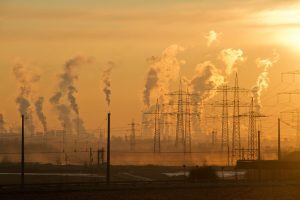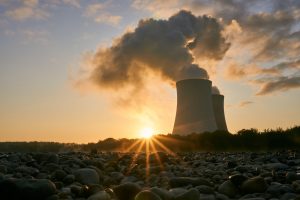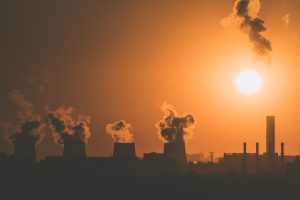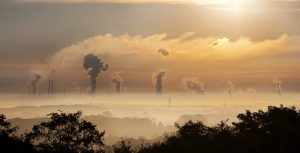Half of all industrial toxic air pollution comes from power plants, and 6,700 power plants and heavy industries are responsible for 80 percent of all greenhouse gas emissions in the United States. Coal- and oil-fired power plants contribute 44 percent of all toxic air pollution. Toxic mercury and emissions from the country’s electricity sector are estimated to cause tens of thousands of premature deaths, heart attacks, asthma cases and chronic bronchitis.


Number 1: Ohio
Ohio’s electricity-generation sector emitted more than 36.4 million pounds of harmful chemicals in 2010, accounting for 62% of state pollution and about 12% of toxic pollution from all US power plants. The state also ranked 2nd in industrial mercury air pollution from power plants, emitting almost 4,210 pounds in 2010 (73 percent of the state’s mercury air pollution and 6 percent of US electricity sector mercury pollution).
Ohio is home to the Gen J M Gavin coal plant in Cheshire, which is the 9th biggest polluter in the United States, according to the EPA, which estimates the plant’s greenhouse gas emissions for 2010 at 16,872,856 CO2e.
Number 2: Pennsylvania
Pennsylvania is ranked third on the second annual "Toxic 20" ranking of states whose residents are exposed to the most pollution from coal- and oil-fired power plants. It represents a small improvement over last year, when Pennsylvania ranked second in the nation in the percentage of toxic pollution generated by power plants. Pennsylvania is responsible for some 10% of all toxic pollution from power plants in the US, releasing nearly 32 million pounds of harmful chemicals in 2010 alone.
From 2009 to 2010, air pollution from all sources in Pennsylvania dropped by 20 percent and from coal-fired power plants by 24 percent, according to HRDC.


Number 3: Florida
While the EPA ranked Florida the 6th worst polluter in 2010, the NRDC ranked it as 2nd worst in its 2012 list. Florida’s electricity-generation sector emitted nearly 16.7 million pounds of harmful chemicals in 2010, according to the EPA, accounting for 57 percent of all state pollution and 5 percent of toxic pollution from all US power plants. Florida’s electricity sector emitted some 1,710 pounds of mercury into the air, accounting for 75 percent of the entire state’s mercury air pollution for that same year.
Florida has undergone a major shift from coal to natural gas. Twelve years ago, natural gas accounted for less than 30 percent of Florida’s electricity production. By 2011, Florida was generating 62 percent of its total power from natural gas, with coal accounting for 23 percent. (Only Texas has a higher percentage.) Florida has three nuclear power plants, which accounted for just under 10 percent of electricity generation in 2011. Florida has 10 large power plants, eight of which are now fueled by natural gas.
However, despite the shift from coal to natural gas, Florida’s carbon dioxide emissions have continued to increase, while sulfur dioxide emissions have been reduced. Florida has seen its greenhouse gas emissions increase from 91 million tons in 1990 to 124 million tons in 2010.


Number 4: Kentucky
Kentucky may not have been ranked the worst overall polluter in the US, but it is ranked worst in terms of toxic air pollution from coal-fired power plants, with HRDC officials specifically citing Kentucky’s poor control over these plants and its failure to adopt any laws or regulations that would lead to a notable reduction in pollution.
Kentucky’s electricity sector actually saw an increase in toxic air pollution from 8.8 million pounds in 2009 to 9.6 million pounds in 2010.
It’s not likely to improve much. Just one day after a federal appeals court scrapped the EPA rule to curb long-distance power plant pollution drifting, the Kentucky-based Big Rivers Electric Cooperative power plant announced it would abandon pollution controls that would have allowed it to comply with the EPA’s regulation.
Number 5: Maryland
Ranked 5th overall for total industrial pollution, coal-burning power plants keep Maryland higher on the pollution list than the state would like. In terms of coal-burning power plant pollution, Maryland is ranked 19th by the NRDC, which also noted that the state’s toxic emissions from power plants dropped by 88 percent over the course of one year. The biggest polluters are the Chesterfield, Chesapeake and Clinch River power plants.
Number 6: Indiana
The Gibson coal plant in Owensville had total greenhouse gas emissions of 17,993,350 CO2e in 2010, according to the EPA, which ranked the plant the fifth worst polluter in the US. The state’s Rockport coal plant ranked the 10th worth polluter in the country, with total greenhouse gas emissions of 16,666,035 CO2e.
Number 7: Michigan
Michigan’s electricity sector emitted over 15.5 million pounds of harmful chemicals, which translates into 61 percent of all state pollution and 5% of power plant pollution countrywide. The sector also caused around 2,250 pounds of mercury air pollution, which is 82 percent of the state’s entire mercury air pollution and 3 percent of the country’s electricity sector mercury pollution.
The Monroe coal plant registered total greenhouse gas emissions 17,850,341 CO2e with the EPA in 2010, making it the country’s 6th worst polluter.
Michigan has not increased or reduced pollution in the electricity sector since the last ranking in 2009. The only thing saving Michigan’s air is a decline in manufacturing, which of course is not the ideal.
Number 8: West Virginia
West Virginia’s electrical power generation was responsible for over 80 percent of toxic industrial air pollution in the state, while the chemical sector was responsible for 10 percent. In 2010, West Virginia’s electricity sector emitted 18.1 million pounds of harmful chemicals, or 81 percent of all state pollution and 6% of the country’s total power plant pollution. In terms of mercury air poisoning, 2,500 of toxic mercury were released into the air in 2010.
The biggest polluters are power plants owned by Allegheny Energy, AEP and Dominion.
Incidentally, West Virginia has the highest per capita mortality risk from fine particle pollution among states.
Number 9: Georgia
According to the EPA, Georgia’s Scherer coal-fired power plant near Macon is the number one producer of greenhouse gases in the United States, emitting 22.8 million metric tons of carbon dioxide alone in 2010.
Georgia is also home to the second worst polluter in terms of carbon dioxide emissions, with its Bowen Plant in Cartersville, which boasted total greenhouse gas emissions of 21,026,397 in 2010. This plant was also listed as the largest emitter of sulfur dioxide in 2006 and blamed for a variety of health issues, from asthma, bronchitis and heart disease to lung disease and pneumonia. Plans are reportedly under way for the installation of scrubbers on the plant’s four cooling towers to remove sulfur dioxide from exhaust before it is released into the air.
Number 10: North Carolina
North Carolina’s electric sector ranked 8th in industrial toxic air pollution in 2010, emitting more than 14.6 million pounds of harmful chemicals, or 48 percent of state pollution and about 5 percent of total US toxic pollution from power plants. In terms of mercury air pollution from power plants, North Carolina ranked 24th, producing some 960 tons of toxic mercury in 2010, or 47 percent of mercury air pollution in the state.
This story originally appeared on Oilprice.com. Click here to read the orginal story. By Jen Alic of Oilprice.com
Disclaimer: Gocyberbiz.com is not affiliated to Oilprice.com nor it"s third party ads.
